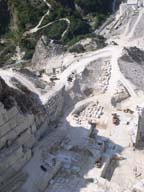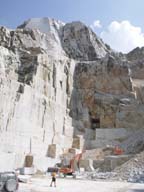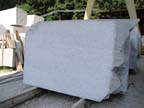

The stone is currently being fabricated by Campolonghi Italia S.p.A. at the La Facciata quarry site. The material has been used for several exterior projects, including load-bearing temples, which gave the architects confidence that the stone would be suitable for the project from a practical standpoint.
A total of 20,000 tons of stone is being quarried for the project, and it comes from one specific section - which has further been broken down into four sub-sections. Representatives from Snøhetta visited the quarry site to determine what would be most appropriate for the project, which it refers to as a “sculpted landscape.†The building form will have a “landmark quality obtained through a memorable yet discreet silhouette,†according to the architects, with a sloping roof rising directly from beneath nearby fjord. This vision for a Norwegian landmark is being made a reality over 1,000 miles to the south in Carrara, Italy, where Campolonghi's team is currently extracting and processing stone to be shipped to the jobsite in Oslo.

The quarry process
The La Facciata quarry is located high in the Apuan Alps, reachable only by four-wheel-drive vehicles. It was necessary to extract the stone from the highest level of the mountain in order to obtain the proper quality and structural characteristics, according to Campolonghi, which began working the upper levels six years ago, extracting 300,000 tons of stone during that time.The quarry operations have been documented for 300 years, but there is evidence that stone was taken from the site as far back as Roman times. Workers at the site have discovered hand-carved bowls as well as signs of quarrying activity in discarded blocks.
Today, the stone is extracted using modern techniques and machinery, including diamond wire saws from Pellegrini and Lochtmans. The quarry master is Stefano Lorenzoni, whose family has been working in the quarry for 100 years. Lorenzoni explained
that even with the technological advancements in place, the quarry operation is still very much a creative process. There are no standard methods that can be followed because the quarry master and geologists must “read†the earth to determine how to approach the extraction for each individual area.
A total of 17 employees are working in the quarry, including one foreman, and the quarry will produce 40,000 tons of material in 2005. The production rate this year was actually lower than previous years, because of the preparation and time needed to extract blocks specifically for the Oslo project.
Most of the stone will have a bushhammered or pickhammered finish, and other pieces will have a “corduroy†finish, with grooves carved into the surface. In choosing the quarry locations to obtain blocks, color concern was actually secondary, as the primary goal was having a stone with the right “feel†and texture.
The quality control for block production is so strict that blocks are approved at the quarry as soon as they are extracted. After the blocks are washed, a second approval process takes place at the adjacent fabrication plant. Prior to being processed, each block is inspected, and a determination is made on which specific architectural pieces will be taken from the block. Also, to ensure that the blocks being extracted have the proper flexural and compressive strength, an independent firm tests 10% of the blocks being quarried for the project.
The area of the quarry being used for the Oslo Opera House actually has room for expansion, and the company expects to increase production in this area by a factor of 50% in the near future. The quarry produces gangsaw-sized blocks as well as smaller blocks, and even the rubble and dust is utilized for its calcium carbonate.
Because of increased standards in the international marketplace, the quality of production has also risen, and what would have been commercial grade in the 1980s is now classified as scrap stone.

Fabricating a landmark
Each block is marked with the exact location where it was extracted in the quarry, the date it was quarried and the date it was placed into storage. The company also records all inspection dates and the date the material moves on to the fabrication plant. After the blocks are trimmed and cut into raw slabs, they receive their surface texture, which is generally bushhammered or “pickhammered,†which is slightly rougher.Bushhammering is done on a Barsanti line unit with 18 working heads, and the slabs pass through the bushhammering line in the same manner as they would a slab polishing line. After receiving their surface texture, the stone is moved onto the bridge saw to be cut to the desired size. Material is then inspected and crated for shipment. An inspector from Oslo supervises the fabrication work, and the block of origin is recorded for each piece shipped.
The finished pieces have a nominal size of 62.5 cm high in various lengths. Flooring pieces are 8 cm thick, while cladding pieces are 5 cm thick. There also some larger pieces ranging from 10 to 25 cm thick.
In addition to the work being fabricated at the La Facciata site, more advanced fabrication work is being completed at Campolonghi's main facility in Massa. For example, the grooved “corduroy†finish pieces are being fabricated in Massa using a multi-axis stoneworking machine from Omag.
Although 20,000 tons of stone are being quarried for the project, the final total after fabrication will actually be 10,000 tons. The project is expected to be completed in mid-2006, creating a permanent fixture in Oslo's culture and architecture.